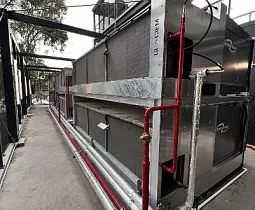A new report highlights common faults in residential and commercial refrigeration and air conditioning equipment – and the considerable potential benefits of addressing them.
Heating, ventilation, air conditioning and refrigeration (HVAC&R) has a huge impact on Australia’s energy use and greenhouse emissions. HVAC&R uses more than 24 per cent of electricity generated in the country, and contributes about 11.5 per cent of our total emissions. This includes direct emissions – refrigerants leaking from systems – as well as indirect emissions from the energy that the systems use.
The new report, developed by the Expert Group for the Department of Agriculture, Water and the Environment, points out thatsimple steps such as routine maintenance could lower these numbers.
AIRAH CEO Tony Gleeson, M.AIRAH, says this information is crucial for a country pushing towards a sustainable future.
“As we drive towards our Paris Treaty targets of 2030, and beyond that towards net zero,” says Gleeson, “We must focus on thesectors where we can claim the biggest wins.
“We already know that heating and cooling uses almost a quarter of our country’s energy, and that there is potential for significant savings. This new report begins to quantify thosesavings and tells us how to unlock them with specific measures.”
The report, titled Leaks, maintenance and emissions: refrigeration and air conditioning equipment, notes that the single most important measure to improve RAC equipment performance is to eliminate leaks of refrigerant gas.Other common faults include dirty condensers and evaporators and associated mechanical problems; issues with system capacity and mismatched components; control systems, sensors and wiring issues; and poor equipment location.
The report confirms that these common faults occur across most equipment segments, and a large majority are related to maintenance or can be addressed by routine maintenance.AIRAH has extensive experience in this area,having published the industry guide to HVAC&R maintenance, DA19, for more than 20 years.
“There were no surprises for us that these faults are widespread and costing businesses money,” says Gleeson.“The good news isthat the solutions are simple, and can be done straightaway – better leak detection, for example, ormaintenance.”
A study quoted in the report estimated that a strategy involving leak inspection routines and automatic leak detection on certainclasses of commercial RAC equipment could avoid theequivalent of 8.5Mt CO2ein direct emissions and indirectemissions savings of 4.7Mt CO2e by 2030.Similarly, maintenance activities on certain classes of commercial RAC equipment through to 2030 could save 38.1Mt CO2e. And according to the Kigali Cooling Efficiency Program, optimisation, monitoring and maintenance of cooling technology can reduce total cooling emissions by 13 per cent.
Gleesonsays that it is vital to spread the message.
“To anyone responsible for HVAC&R systems,” says AIRAH’s Gleeson,“whether they be building owners or facilities managers, or even tenants dealing with the systems on a daily basis – we urge you to review your maintenance regime and consult an expert to find out how your system could be improved.
“Australia’s sustainable future will be underpinned by well-maintained and environmentally effective HVAC&R systems. We look forward to supporting the government as we highlight the opportunities in our sector to the wider public.”
